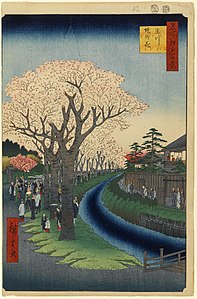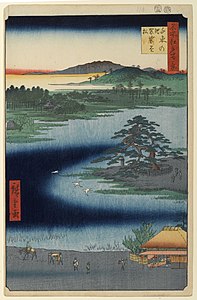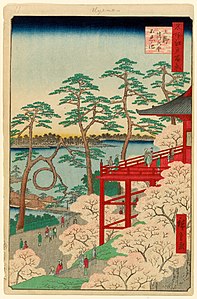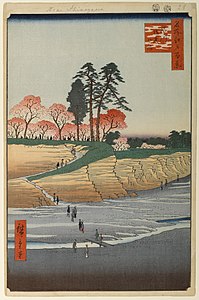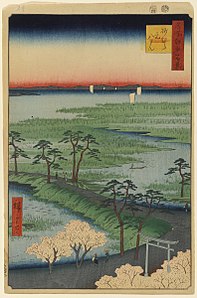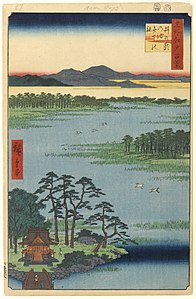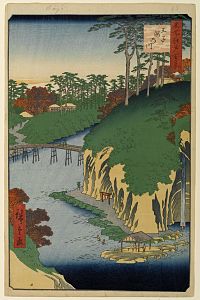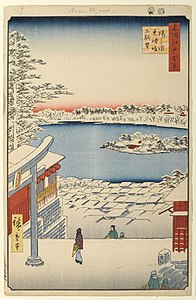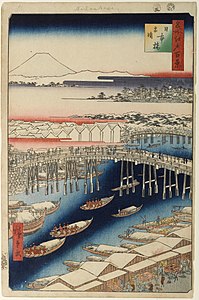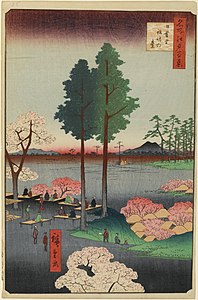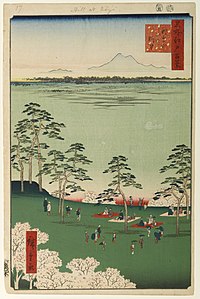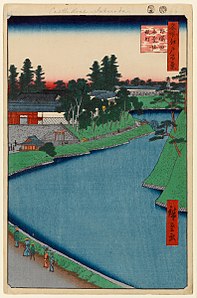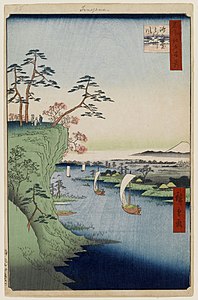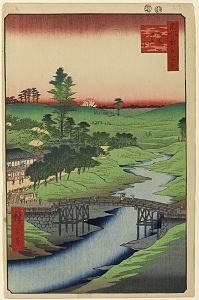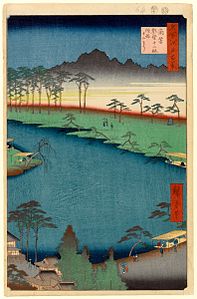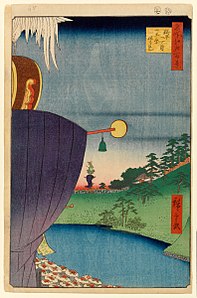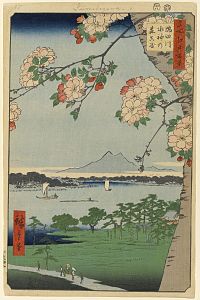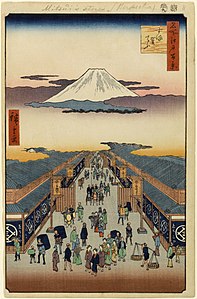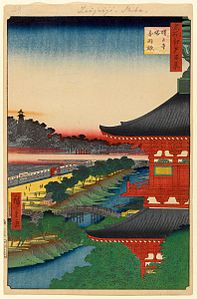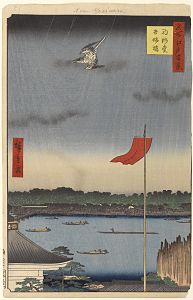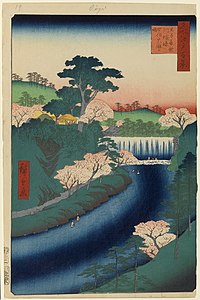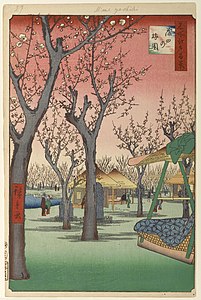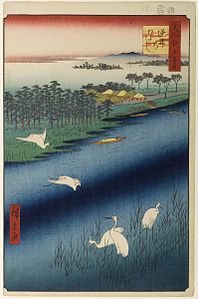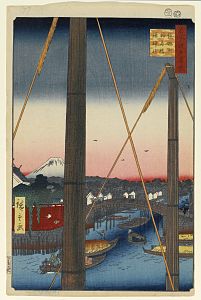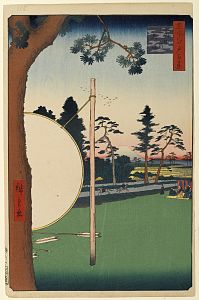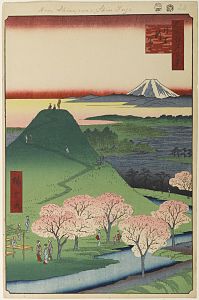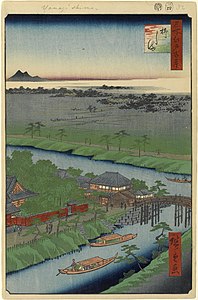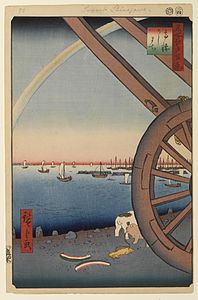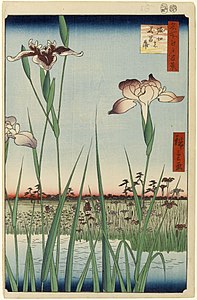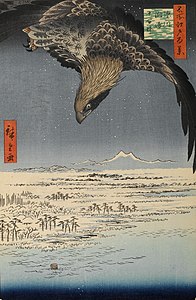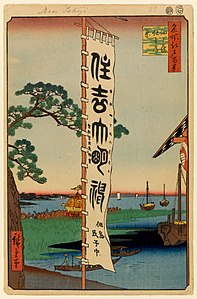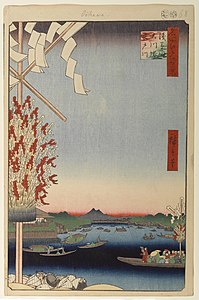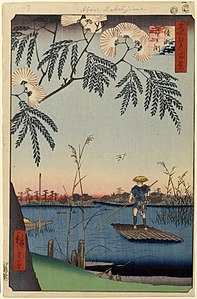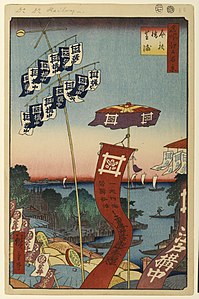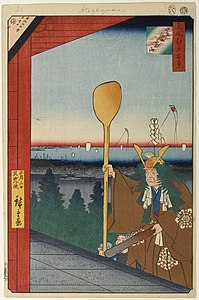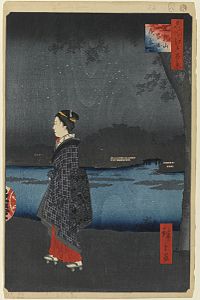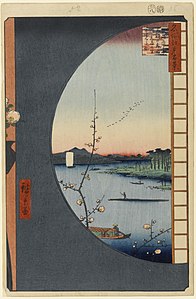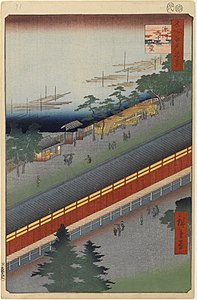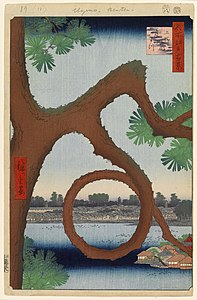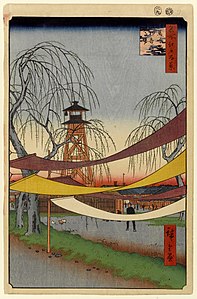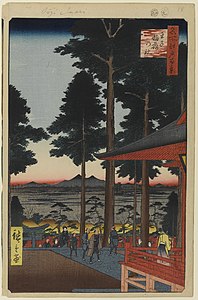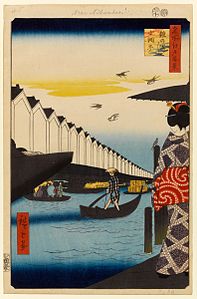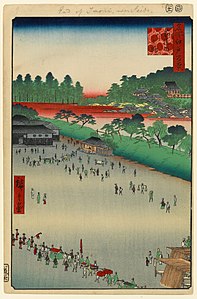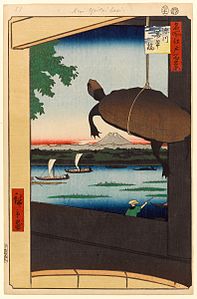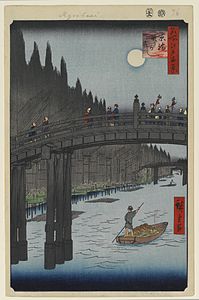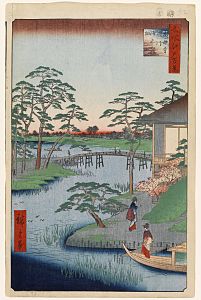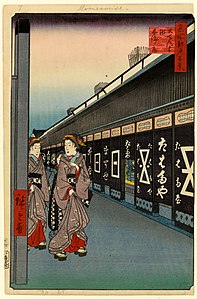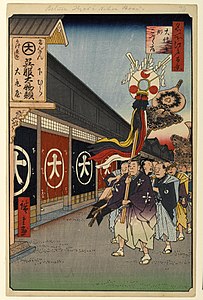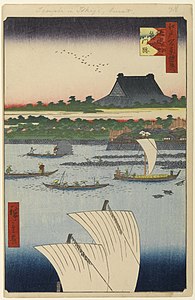100 famous views of Edo

The 100 Famous Views of Edo ( Japanese 名 所 江 戸 百 景 , Meisho Edo hyakkei ) are a color woodcut series by the Japanese painter and color woodcut artist Utagawa Hiroshige . The series, which, contrary to the wording of the title, consists of a total of 119 prints and a title page, is considered to be the artist's main work. He himself described the prints in this series as his best work that should represent his artistic legacy.
Preliminary remark
In the years 1829–36, an illustrated guide published Pictures of Famous Places by Edo ( 江 戸 名 所 図 会 , Edo meisho zue), started by Saitō Yukio (1737–1799) in 1790 and revised by his son Yukitaka and grandson Yukinari had been added. The total of 20 volumes of the seven-part guide were accurately illustrated by Hasegawa Settan (1778–1848). Pictures and text describe in detail the large temples and shrines, but also a whole range of famous shops, tea houses, restaurants, etc. In addition, there are landscapes and picturesque areas in the city and its surroundings.
Hiroshige, who took over a number of motifs from this guide in his 100 famous views , depicted not only Edo but also its surroundings on individual woodcuts. Roughly half of the sheets concern the city itself, the smaller half the surroundings. But the city also appears very green on Hiroshige's prints, with many rivers and canals running through it. The endless, uniform sea of houses would have been pretty boring.
Hiroshige's 100 views
For the series there is a table of contents ( Mokuroku ) dated to the 10th month of the horse year (1858) , which was commissioned by the publisher Sakanaya Eikichi (Uoya Eikichi) from Gengyo Miyagi (Baisotei Gengyo) and which serves as the cover sheet of the complete editions of the series served, which were printed from the specified date. This table of contents groups the sheets of the series according to the four seasons and gives them a certain order, even if not every sheet can actually be assigned to a season. Most of the representations of the series in the literature follow the order of the mokuroku ; Art historians, however, consider the order artificial and a subsequent "invention" by the publisher. Hiroshige himself did not envisage a specific order and the prints are not numbered consecutively. In this article, the arrangement in the Geidai Collection is adopted. The leaves are presented there in the order in which they were created, beginning with the 2nd month in 1856.
Some of the most famous sheets in the series, including a. those modeled on Vincent van Gogh in oil paints - shower over the great bridge in Atake (no. 92) and the plum tree garden in Kameido (no. 97) - were only created by Hiroshige towards the end.
Three sheets, the numbers 116 to 118, are dated like the Mokuroku to the 10th month 1858, one month after Hiroshige's death, who according to the Japanese calendar had died in the 9th month of the year. Because of stylistic subtleties and small differences in the signatures, these three prints are ascribed to his student Shigenobu, who took the name from his teacher and is known in literature as Hiroshige II. Sheet 119, which only appeared in the 4th month of 1859, is certainly from Hiroshige II. In the collective editions of the series, the print replaced the sheet “Paulownien in Akasaka” (No. 9) after its publication; the reasons for this are unknown; the old printing plates may have been lost.
The translation of the original caption (this can be found e.g. in Japanese or English) tries to find a compromise between location and factual information. The ending -yama indicates a mountain, -zaka indicates a hillside path, -gawa indicates a river and -hashi / -bashi indicates a bridge. Supplements are put in brackets, the square brackets indicate the year of origin followed by the month.
Explanations of individual sheets

- When looking over the city to the southwest, Fuji, 100 km away, can occasionally be seen on the leaves. If you look to the northeast you can see (e.g. on sheet 17) a mountain with a double peak : this is the 876 m high Tsukuba , which is only 60 km away. It is not a volcano, not even an extinct one.
- (1) The leaf is called flowers (= cherry blossom ) on the dike of the Tama-gawa , but it is the Tamagawa-jōsui, a canal that branches off from the Tama-gawa and was built between 1653 and 1654 to improve the water supply in Edo had been. The cherry blossom near the canal at Koganei was and is famous .
- (26) The Kameido shrine is dedicated to the scholar Sugawara no Michizane (845–903). The complex is a copy of the main shrine in Dazaifu ( Kyūshū ) with the large and small drum bridge . The shrine was destroyed in World War II, but has been rebuilt (changed). The wisteria blossom is famous.
- (28) Kinryūsan in Asakusa . The temple gate on this beautiful winter leaf leads to the popularly called Asakusa-dera ( 浅 草 寺 ), which is not visible in the picture. Its mountain name ( 山 号 ) is Kinryū, golden dragon . The temple is not the most important in the city, but it is certainly the most popular.
- (32) The Shubi pine on the Ommaya / Oumaya bank ( 御 厩 ) is a popular Ukiyo-e topic: During boat trips, women were happy to rest under the pine tree in a difficult-to-see part of the Bakufu port facilities on the Sumida River . Shubi means "from head to toe", which may not refer to the jaws but to the occupants of the boat. The old port facilities have long since disappeared, but you can find a (recently replanted) pine tree.
- (81) The Sazaidō of the 500-Rakan Temple was a two-story building with a beautiful view. Its popular name, d. i. "Snail hall", he has from the spiral staircase inside. Hiroshige depicts the tower more correctly than Hokusai in his 36 views: Hokusai expands the handling to create a beautiful foreground. Because of the constant flooding, the temple was later abandoned at this point. It still exists in a reduced form in the Meguro district .
Sazaidō in Hokusai's " 36 Views of Mount Fuji "
- (91) The Fudō waterfall in Ōji in today's Kita district takes its name from Fudō-myōō , a Buddhist deity. There are various explanations as to how the waterfall got this name. The top is adorned with a shimenawa , a Shinto symbol: In the Edo period there was hardly any fear of contact between Buddhism and Shintoism. The waterfall no longer exists today.
- (97) The old tree in the foreground of the plum garden leaf copied by van Gogh was famous because a large branch fell to the ground and then rose again. He was known as the prostrate dragon ( 臥龍 , garyū). Unfortunately, the tree was lost in a flood in the early 20th century.
The 119 leaves
11. Benten Shrine at Inokashira Pond
13. View from Yushima Tenjin Shrine
14. Nihonbashi in the snow in clear weather [1856-05]
26. On the grounds of the Kameido Tenjin Shrine
37.Saruwaka-chō ( Kabuki Theater District)
38. Kasumigaseki [1857-01]
39. Akabane and the pagoda of the Zōjō-ji [front right]
40. Komagatadō and Azumabashi
88. Dawn at Kanda Myōjin Shrine
111. Teppōsū and the Tsukiji Monzeki Temple
Web links
Remarks
- ↑ Edo, like all cities except the old imperial cities, had no city wall. Trenches, gates and fortifications existed only in the area of Edo Castle.
- ↑ The dates follow the Japanese literature: They are the original ones according to the then valid lunisolar calendar and month information can therefore deviate from the western calendar by up to two months.
- ↑ The location information follows the Geidai Collection. This occasionally results in readings deviating from Trede and Bichler, both of which are common, e.g. B. Ommaya here, Oumaya there.
- ↑ The correct name is Sansōdō.
literature
- M. Trede, L. Hiroshige Bichler: A Hundred Famous Views of Edo. Taschen Verlag 2010, ISBN 978-3-8365-2145-1 .
- Geidai Collection: Utagawa Hiroshige's One Hundred Famous Views of Edo. Tokyo University of Fine Arts, Catalog 2007 (in Japanese).
- Nihon chimei daijiten. 13 Tōkyōto. in: Large lexicon of Japanese place names. Volume 13 - Tōkyō-to. Kadokawa Publishing House 1978.
- Edo meisho zue. ( 江 戸 名 所 図 会 ), 7 volumes. Publishing house Kadokawa Bunkō, 1966 (reprint with commented).





